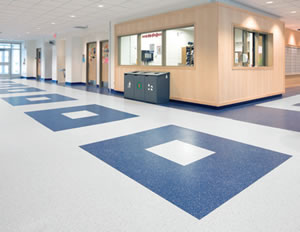Flooring Stands up to Harsh Conditions

nora flooring has proven its ability to stand up to high traffic
volume and harsh winters at Syracuse University.
Founded in 1870, Syracuse
University in New York educates
a student body of approximately
21,000 each year. With 70 percent of
students living in the school’s 22 residence
halls, the team overseeing housing has
much to consider as they work to keep dormitories
comfortable, safe and up-to-date.
Searching for a floor covering that could
stand up to high-volume traffic and the
brutal Syracuse winters, while offering
a streamlined maintenance routine, the
team selected nora rubber flooring to cover
dorm entrance areas, corridors, common
spaces and stairwells. Over the past seven
years, the floor has outperformed expectations.
“The versatility of nora lends itself
to many different spaces,” says Robert J.
Spagnoletti, manager of maintenance.
Spagnoletti offers an example of the
transformation that has taken place in dorm
stairwells. “The stairwells were previously
concrete with a tread,” he says. “The way the
nora all-in-one stair tread piece fits over the
existing steps was just perfect. Installation
was simple and easy, dealing with one piece.
The stairs don’t look industrial any longer;
they just look nice, and the rubber adds an
element of safety.”
The floor’s easy maintenance regimen,
which eliminates the use of coatings and
wax, played a key role in the selection of
rubber flooring. “That was a main driving
factor,” says Spagnoletti. “We found a good
product that we don’t have to wax and
strip.” Since its installation, the nonporous
rubber flooring has proven it can stand up
to anything and deliver on performance.
“Our biggest challenge is the winters
and dealing with the snow and salt, keeping
the salt down outside, but minimizing
the trailing effect inside,” Spagnoletti
shares. The flooring has performed so
efficiently that the maintenance team is
using spare tiles of nora as walk-off pads
for elevators during the winter.
“We’re getting strong support from all
of our directors. They see the areas where
nora has been installed and are happy with
how it’s worked,” Spagnoletti says.
nora.com/us
This article originally appeared in the issue of .